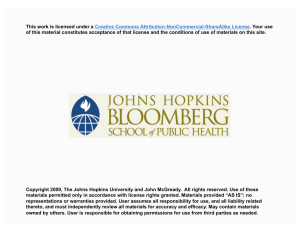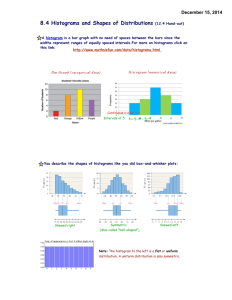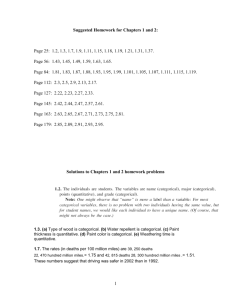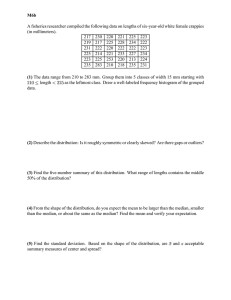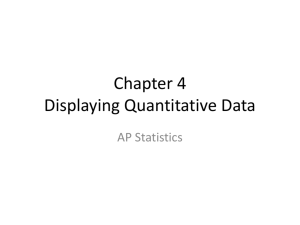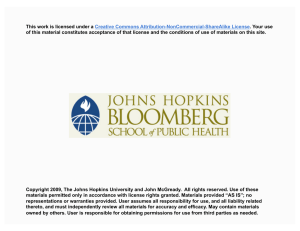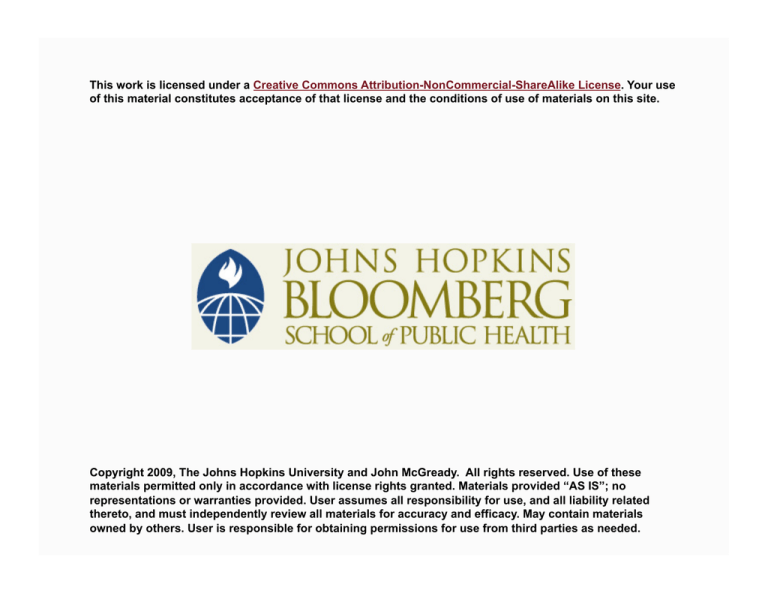
This work is licensed under a Creative Commons Attribution-NonCommercial-ShareAlike License. Your use
of this material constitutes acceptance of that license and the conditions of use of materials on this site.
Copyright 2009, The Johns Hopkins University and John McGready. All rights reserved. Use of these
materials permitted only in accordance with license rights granted. Materials provided “AS IS”; no
representations or warranties provided. User assumes all responsibility for use, and all liability related
thereto, and must independently review all materials for accuracy and efficacy. May contain materials
owned by others. User is responsible for obtaining permissions for use from third parties as needed.
Lecture 1f: Practice Problem Solutions
John McGready
Johns Hopkins University
Practice Problems
1. The following histogram shows the distribution of medical
expenditures (in U.S. dollars in the year 1987) for participants in
the National Medical Expenditures Survey (NMES)
- Mean: $2,300; Median $588; SD $4,957
3
Practice Problems
a) How would you characterize this distribution (symmetric, right
skewed, etc.)?
- While this is somewhat of a subjective question, I assume most
of us would not hesitate to call this a “right-skewed”
distribution
- The extreme values are large relative to the majority; and the
mean is much larger than the median
4
Practice Problems
b) Suppose you take a random sample of 100 observations from this
“population” of over 13,000 respondents. What shape will the
histogram of the these sample values likely have?
- As the sample is random, it’s characteristics should mimic the
characteristics of the larger population of values form which it
is selected
- As such, the distribution of the 100 sample values will also
likely be right skewed
5
Practice Problems
c) Suppose you take a random sample of 2,000 observations from this
“population” of over 13,000 respondents. What shape will the
histogram of the these sample values likely have?
- Again, as the sample is random, it’s characteristics should
mimic the characteristics of the larger population of values
from which it is selected
- As such, the distribution of the 2,000 sample values will also
likely be right skewed
6
Practice Problems
d) Which random sample, the sample of 100 or the sample of 2,000
will have a larger sample standard deviation?
- There is no way to answer this question without knowing the
sample standard deviations for each of the sample sets
- While these sample standard deviations will likely differ in
value, they are estimating the same underlying population
quantity
- There is no systematic link between the sample size and the
relative magnitude of sample estimates
7
Practice Problems
2. The following boxplot shows the distribution of self-reported
weights (in pounds) of 336 students enrolled in an introductory
biostatistics course at JHBSPH in year 2007 (not 611!)
- Mean: 145 lbs; median 141 lbs; SD 31 lbs
8
Practice Problems
a) How would you characterize this distribution (symmetric, right
skewed, etc.)?
- Again, a subjective question
- My take: a relatively symmteric distribution but with a slight
right skew
- The median is slightly closer to the 25th percentile than the
75th percentile, and is smaller in value than the mean (but not
by a relatively large difference as we saw with the medical
expenditures data)
- However, the outliers are balanced between small and large
extremes and the smallest and largest non-outlying values are
similar distance from the “box”
9
Practice Problems
b) Suppose this sample is representative of all graduate students at
JHBSPH enrolled in 2007. What does this sample suggest about the
distribution shape for the weights of all graduate students in 2007
at JHBSPH?
- If this sample is representative, then the distribution of
population values should have the same characteristics as the
sample distribution (i.e., relatively symmetric with a slight
right skew)
10
Practice Problems
c) Students self selected to participate in this survey (there were more
than 336 enrollees in this other introductory class). How might this
impact the representativeness of the sample with regards to all
JHBSPH graduate students in 2007?
- Some possibilities:
Heavier (or lighter) persons most likely not to participate
Students enrolled in a certain degree program collectively
decide not to participate
MPH students much more likely to participate than any
other degree seeking students
11
Practice Problems
3. The following histogram shows the temperature measured at 12
noon on everyday of a fifteen year period for the U.S. city of
Philadelphia. (5,471 days)
- Mean: 54; median 55; SD 18
12
Practice Problems
a) How would you characterize this distribution? (symmetric, right
skewed, etc.)
- This distribution defies classification!
- Well at least simple classification
- There is a slight left skew in the histogram (and the mean is
slightly lower in value than the median)
- However, ignoring this minor left skew, the majority of the
distribution is relatively uniform—however others may argue
that its multi-modal
13

